Sample Graph - actual graph Image See here
Code to generate Vertex
graph.addV("organization")
.property("name", "CITI")
.property("type", "ORG")
.property(T.id, "1")
.property("orgName", "CITI")
.iterate();
graph.addV("component")
.property("name", "comop1")
.property("type", "Physical")
.property("orgName", "CITI")
.property("app", "APP1")
.property(T.id, "4013496")
.iterate();
graph.addV("component")
.property("name", "comp2")
.property("app", "APP2")
.property("orgName", "ORG")
.property("type", "System")
.property(T.id, "2105820")
.iterate();
graph.addV("component")
.property("name", "comp3")
.property("app", "APP2")
.property("orgName", "CITI")
.property("type", "Logical")
.property(T.id, "2105830")
.iterate();
graph.addV("component")
.property("name", "comp4")
.property("app", "APP2")
.property("orgName", "CITI")
.property("type", "Logical")
.property(T.id, "2100982")
.iterate();
graph.addV("component")
.property("name", "comp5")
.property("app", "APP3")
.property("orgName", "CITI")
.property("type", "Logical")
.property(T.id, "4007086")
.iterate();
graph.addV("component")
.property("name", "comp6")
.property("app", "APP3")
.property(T.id, "4007087")
.property("orgName", "CITI")
.property("type", "Logical")
.iterate();
graph.addV("component")
.property("name", "comp7")
.property("app", "APP3")
.property("orgName", "CITI")
.property("type", "Logical")
.property(T.id, "4003585")
.iterate();
graph.addV("component")
.property("name", "comp8")
.property("app", "APP3")
.property("orgName", "CITI")
.property("type", "Logical")
.property(T.id, "4003586")
.iterate();
graph.addV("organization")
.property("name", "BOFA")
.property("orgName", "BOFA")
.property("type", "Logical")
.property(T.id, "2")
.iterate();
graph.addV("organization")
.property("name", "JPMC")
.property("orgName", "JPMC")
.property("type", "Logical")
.property(T.id, "3")
.iterate();Code to generate Edges
graph.addE("commercialService").property("name", "CS1").property(T.id, "edge1").from(__.V("1")).to(__.V("4013496")).iterate();
graph.addE("commercialService").property("name", "CS2").property(T.id, "edge2").from(__.V("1")).to(__.V("4013496")).iterate();
graph.addE("commercialService").property("name", "CS1").property(T.id, "edge3").from(__.V("4013496")).to(__.V("2105820")).iterate();
graph.addE("commercialService").property("name", "CS2").property(T.id, "edge4").from(__.V("4013496")).to(__.V("2105820")).iterate();
graph.addE("commercialService").property("name", "CS1").property(T.id, "edge5").from(__.V("2105820")).to(__.V("2105830")).iterate();
graph.addE("commercialService").property("name", "CS2").property(T.id, "edge6").from(__.V("2105820")).to(__.V("2105830")).iterate();
graph.addE("commercialService").property("name", "CS1").property(T.id, "edge7").from(__.V("2105830")).to(__.V("2100982")).iterate();
graph.addE("commercialService").property("name", "CS2").property(T.id, "edge8").from(__.V("2105830")).to(__.V("2100982")).iterate();
graph.addE("commercialService").property("name", "CS1").property(T.id, "edge9").from(__.V("2100982")).to(__.V("4007086")).iterate();
graph.addE("commercialService").property("name", "CS2").property(T.id, "edge10").from(__.V("2100982")).to(__.V("4007087")).iterate();
graph.addE("commercialService").property("name", "CS1").property(T.id, "edge11").from(__.V("4007086")).to(__.V("4003585")).iterate();
graph.addE("commercialService").property("name", "CS2").property(T.id, "edge12").from(__.V("4007087")).to(__.V("4003586")).iterate();
graph.addE("commercialService").property("name", "CS1").property(T.id, "edge13").from(__.V("4003585")).to(__.V("2")).iterate();
graph.addE("commercialService").property("name", "CS2").property(T.id, "edge14").from(__.V("4003586")).to(__.V("3")).iterate();I have this sample graph, initially 2 edges are coming until they separate out, E1,E2...E14 are the edge ID's and CS1 and CS2 are "name" property of edge.(See Image attached above "Sample Graph")
I am trying to get simple path using the below query
This is a java gremlin query
graph.V("1").
repeat(outE().otherV().simplePath()).
until(outE().count().is(0)).
dedup().
group().
by("name").
by(path()).
next();
This gives me result as Map<Object, Object>, where key as JPMC and BOFA and 2 different path's as map value.
path[v[1], e[edge1][1-commercialService->4013496], v[4013496], e[edge4][4013496-commercialService->2105820], v[2105820], e[edge6][2105820-commercialService->2105830], v[2105830], e[edge7][2105830-commercialService->2100982], v[2100982], e[edge10][2100982-commercialService->4007087], v[4007087], e[edge12][4007087-commercialService->4003586], v[4003586], e[edge14][4003586-commercialService->3], v[3]]But when iterate over this path in Java and try to find the edge property "name", I am getting value as CS1 and CS2. It seems when graph is preparing the path it doesn't matter which edge is used to reach the next node.
Where as I am looking for something where we can get the path grouped by "name" property of the edge, like below
path[v[1], e[edge1][1-commercialService->4013496], v[4013496], e[edge3][4013496-commercialService->2105820], v[2105820], e[edge5][2105820-commercialService->2105830], v[2105830], e[edge7][2105830-commercialService->2100982], v[2100982], e[edge9][2100982-commercialService->4007087], v[4007087], e[edge11][4007087-commercialService->4003586], v[4003586], e[edge13][4003586-commercialService->3], v[2]]2nd Solution tried
graph.V(orgId).repeat(outE().order().by("name").otherV().simplePath()).until(outE().count().is(0)).dedup().path().toList();This time it is always traversing through single Edge, till we reach the common node. Output :
path[v[1], e[edge1][1-commercialService->4013496], v[4013496], e[edge3][4013496-commercialService->2105820], v[2105820], e[edge5][2105820-commercialService->2105830], v[2105830], e[edge7][2105830-commercialService->2100982], v[2100982], e[edge9][2100982-commercialService->4007086], v[4007086], e[edge11][4007086-commercialService->4003585], v[4003585], e[edge13][4003585-commercialService->2], v[2]]
path[v[1], e[edge1][1-commercialService->4013496], v[4013496], e[edge3][4013496-commercialService->2105820], v[2105820], e[edge5][2105820-commercialService->2105830], v[2105830], e[edge7][2105830-commercialService->2100982], v[2100982], e[edge10][2100982-commercialService->4007087], v[4007087], e[edge12][4007087-commercialService->4003586], v[4003586], e[edge14][4003586-commercialService->3], v[3]]- There is also a way to pass on the "name" property value in the query itself to follow particular path. But I don't have that value with me to pass on. Instead I am thinking if we can some how use the "name" property from the very first edge we encounter in the path ?
- Also is there any way to get all the properties of vertex/edge populated when we fetch the path ?

